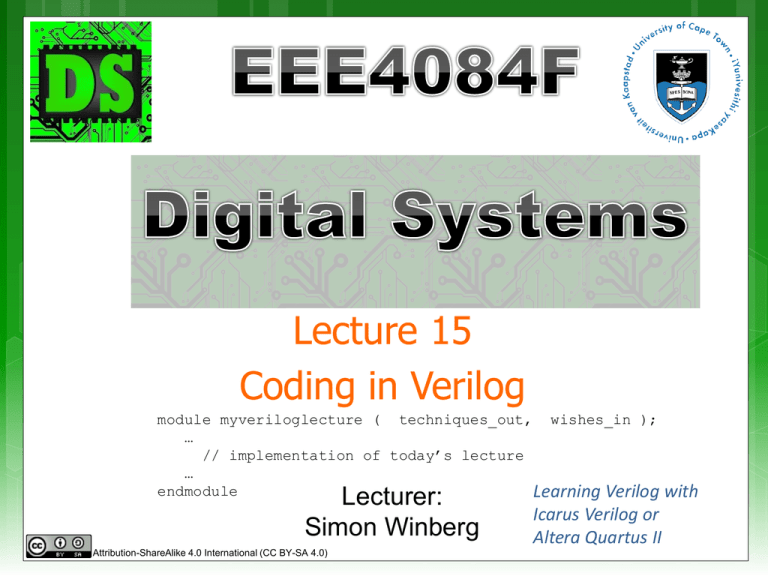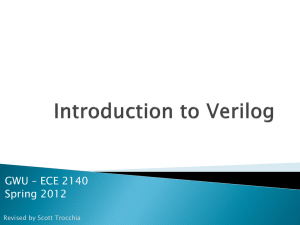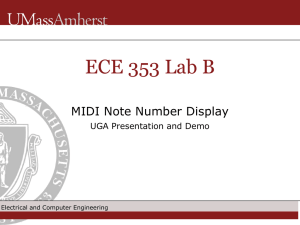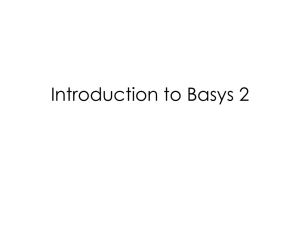Lecture 15
advertisement

Lecture 15 Coding in Verilog module myveriloglecture ( techniques_out, wishes_in ); … // implementation of today’s lecture … endmodule Learning Verilog with Lecturer: Simon Winberg Attribution-ShareAlike 4.0 International (CC BY-SA 4.0) Icarus Verilog or Altera Quartus II Basics of Verilog coding Exercise Verilog simulators Intro to Xilinx Vivado Tends to be more popular in industry than VHDL VHDL is used quite widely in Europe (so is Verilog). Verilog used mostly in USA. Easier to learn since it is similar to C History 1980 of Verilog Verilog developed by Gateway Design Automation (but kept as their own ‘secret weapon’) 1990 Verilog was made public 1995 adopted as IEEE standard 1364-1995 2001 enhanced version: Verilog 2001 … module2 module1 Module: the basic block that does something and can be connected to (i.e. equivalent to entity in VHDL) Modules are hierarchical. They can be individual elements (e.g. comprise standard gates) or can be a composition of other modules. SYNTAX: module <module name> (<module terminal list>); … <module implementation> … endmodule Switch Level Abstraction (lowest level) Gate Level (slightly higher level) Implementing terms of gates like (i.e., AND, NOT, OR etc) and using interconnects between gates. Dataflow Level Implementing using only switches and interconnects. Implementing in terms of dataflow between registers Behavioral Level (highest level) Implementing module in terms of algorithms, not worrying about hardware issues. Close to C programming. Arguably the best thing about Verilog!! Number format: <size>’<base><number> Some examples: 3’b111 – a three bit number (i.e. 710) 8’ha1 – a hexadecimal (i.e. A116 = 16110) 24’d165 – a decimal number (i.e. 16510) Defaults: 100 – 32-bit decimal by default if you don’t have a ‘ ‘hab – 32-bit hexadecimal unsigned value ‘o77 – 32-bit hexadecimal unsigned value (778 = 6310) Constant Hardware Condition 0 Low / Logic zero / False 1 High / Logic one / True x Unknown z Floating / High impedance Wires (or nets) are used to connect elements (e.g. ports of modules) Wires have values continuously driven onto them by outputs they connect to a b // Defining the wires // for this circuit: c d wire a; wire a, b, c; Registers store data Registers retain their data until another value is put into them (i.e. works like a FF or latch) A register needs no driver reg myregister; // declare a new register (defaults to 1 bit) myregister = 1'b1; // set the value to 1 // Define some wires: wire a; // a bit wire wire [7:0] abus; // an 8-bit bus wire [15:0] bus1, bus2; // two 16-bit busses // Define some registers reg active; // a single bit register reg [0:17] count; // a vector of 18 bits Integer 32-bit value integer i; // e.g. used as a counter Real 32-bit floating point value real r; // e.g. floating point value for calculation Time 64-bit value time t; // e.g. used in simulation for delays Parameter: a the rather obscurely named ‘parameter’ works more like a constant in C (or generic in VHLD) Initial: used to initialize parameters or registers or describe a process for initializing a module (i.e. like constructor in C++) Use both in implementation of a module The tradition is to list output ports first and then input ports. This makes reading of code easier. i.e.: ModuleName ( <output ports> <input ports>); module mygate ( xout, // 1 bit output clk , // clock input ain ); // a 1 bit input // define outputs output xout; // define inputs input clk, ain; … rest of implementation … endmodule clk ain mygate xout These are output port that hold their value. An essential feature needed to construct things like timers and flip flops module mycounter ( count_out, // 8 bit vector output of the clk ); // Clock input of the design // Outputs: output [7:0] count_out; // 8-bit counter output // All the outputs are registers reg [7:0] count_out; // Inputs: input clk; … endmodule These two tasks usually done in one go… Modules are instantiated within modules // Multiplexer implemented using gates only* module mux2to1 (a,b,sel,y); U_inv input a,b,sel; sel output y; wire sel,asel,bsel,invsel; a not U_inv (invsel,sel); and U_anda (asel,a,invsel), Module b U_andb (bsel,b,sel); instance Port mapping (like or U_or (y,asel,bsel); names arguments in a C endmodule invsel Syntax: <module name> <instance name> (<arguments>) U_anda asel U_or y bsel U_andb function call) * Based on source: http://www.asic-world.com/code/hdl_models/mux_2to1_gates.v Why In give instances names? Verilog 2001 you can do: module mux2to1 (input a, input b, input sel, output y); … and (asel,a,invsel), // can have unnamed instance … endmodule Major reason for putting a name in is when it comes to debugging: Xilinx tends to assign instance names arbitrarily, like the and above might be called XXYY01 and then you might get a error message saying something like cannot connect signals to XXYY01 and then you spend ages trying to track down which gate is giving the problem. Verilog Primitive Gates and or not nand nor xor Examples: and a1 (OUT,IN1,IN2); not n1 (OUT,IN); Buffer (i.e. 1-bit FIFO or splitter) buf Example: buf onelinkbuf (OUT, IN); buf twolinkbuf (OUT1, OUT2, IN); BufIf (hardware if gate) Tri-state buffer. Can choose to drive out with value of in (if ctr = 1) or don’t drive anything to out (i.e. if ctr = 0 connect high impedance to out) in out in ctr bufif1 (out, in, ctr) bufif1 operation 0 1 x z ctr 0 z z z z 1 0 1 x x x L H x x z L H x x See also notif (works in the apposite way: if ctr=0 then drive out with in) The preceding slides have given a very brief look at Verilog, but has covered much of the major things that are used most commonly. It’s best to get stuck into experimenting and testing code in order to learn this language Some thoughts for experimenting to do… Learning Verilog By Example EEE4084F Take-home assignment A B Sum Carry C This is a 4-bit adder design. Try to convert this into Verilog. Try to run on one or a few of the simulation tools presented in next slides… Learning Verilog using Simulators If you’ve got your own laptop / PC consider installing one of the simulators* as a quick way to check syntax and test designs. Various simulators installed on forge.ee, can be accessed remotely * I confess to using Altera Quartus II much of the time since it takes less space to install and runs faster than its obvious rival. image src: https://www.flickr.com/photos/iita-media-library/4479286652/ Learning Verilog One approach is using a block diagram and converting to Verilog HDL. E.g. using Altera Quartus II (See test1.zip for example Quartus project) Learning Verilog One approach is using a block diagram and converting to Verilog HDL. E.g. using Altera Quartus II See how param types are specified See how included modules are instantiated and ports mapped Checking syntax I find a handy tool is the file analyser tool in Quartus II. This can be used to check the syntax of the file without having to go through the whole build process. Testing Load the Test2 file, if using Quartus make sure that mynand is the top level Entity (See test2.zip for example Quartus project that contains only Verilog files and waveform file) Running the simulation should allow you to verify the design is working as planned (i.e. NANDing) Consistent indentation Align code vertically on the = operator Use meaningful variable names Include comments (i.e. C-style // or /**/ ) brief descriptions, reference to documents Can also be used to assist in separating parts of the code (e.g. indicate row of /*****/ to separate different module implementations) Source: Coram: Verilog-A Introduction for Compact Modelers (MOS-AK Montreux 2006) See Verilog tutorials online, e.g.: http://www.verilogtutorial.info/ Icarus Verilog – An open-source Verilog compiler and simulator http://iverilog.icarus.com/ Try iverilog on forge.ee Gplcver – Open-source Verilog interpreter http://sourceforge.net/projects/gplcver/ Try cver on forge.ee Verilator – An open-source Verilog optimizer and simulator http://www.veripool.org/wiki/verilator Comprehensive list of simulators: http://www.asicworld.com/verilog/tools.html Icarus Verilog Probably the easiest free open-source tool available Excellent for doing quick tests. Takes very little space (a few megs) & runs pretty fast. Installed on forge.ee For Ubuntu or Debian you can install it (if you’re linked to the leg server), using: apt-get install iverilog Iverilog parsing the Verilog code and generates an executable the PC can run (called a.out if you don’t use the flags to change the output executable file name) I suggest the following to get to know iverilog… upload mynand.v example to forge.ee, compile it with iverilog. Run it. Try changing the testbest code, put in some more operations http://iverilog.icarus.com/ More Experimenting Try test3 or mycounter.v as a more involved program and test Experiment with using both Altera Qauartus II, Icarus Verilog, and Xilinx ISE ISim Intro to Xilinx Vivado Short video http://www.youtube.com/watch?v=H6W4HKbjnaQ Remember to try doing the 4-bit adder example (see slide 22) Next lecture: RC Architectures Disclaimers and copyright/licensing details I have tried to follow the correct practices concerning copyright and licensing of material, particularly image sources that have been used in this presentation. I have put much effort into trying to make this material open access so that it can be of benefit to others in their teaching and learning practice. Any mistakes or omissions with regards to these issues I will correct when notified. To the best of my understanding the material in these slides can be shared according to the Creative Commons “Attribution-ShareAlike 4.0 International (CC BY-SA 4.0)” license, and that is why I selected that license to apply to this presentation (it’s not because I particulate want my slides referenced but more to acknowledge the sources and generosity of others who have provided free material such as the images I have used). Image sources: man working on laptop – flickr scroll, video reel – Pixabay http://pixabay.com/ (public domain)







